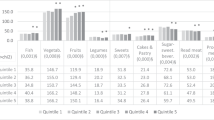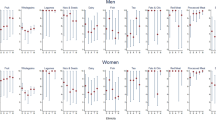Abstract
Background:
Studies from different time periods have shown that consumption of vegetables is more common in higher socioeconomic groups and among women. However, there are only few studies of changes of socioeconomic differences in vegetable consumption over time. Our aim was to determine whether socioeconomic differences, measured by educational level and household income, in daily vegetable consumption have increased, decreased or been stable over the last two decades among Finnish men and women.
Methods:
Data on daily consumption of fresh vegetables were derived from repeated annual cross-sectional surveys performed among representative samples of Finnish working aged (15–64 years) population. Data from the years 1979–2002 were linked with data on education and household income from Statistics Finland. Those under 25 years and all students were excluded, giving a total of 69 383 respondents. The main analyses were conducted with logistic regression.
Results:
Daily consumption of fresh vegetables became overall more prevalent during the study period. Daily consumption of fresh vegetables was more common among those with higher education and higher income during the whole study period. Both educational level and household income differences in daily vegetable consumption slightly narrowed since 1979 among men and women.
Conclusions:
Women with high socioeconomic position have been initial trend setters, but the prevalence of daily consumers of vegetables in these groups has not increased since the early 1990s. The prevalence of daily consumption of fresh vegetables has increased more in lower educational and income groups during the 1980s and 1990s along with narrowing socioeconomic differences.
This is a preview of subscription content, access via your institution
Access options
Subscribe to this journal
Receive 12 print issues and online access
$259.00 per year
only $21.58 per issue
Buy this article
- Purchase on Springer Link
- Instant access to full article PDF
Prices may be subject to local taxes which are calculated during checkout



Similar content being viewed by others
References
Agudo A, Slimani N, Ocke MC, Naska A, EPIC Working Group on Dietary Patterns (2002a). Vegetable and fruit consumption in the EPIC cohorts from 10 European countries. IARC Sci Publ 156, 99–103.
Agudo A, Slimani N, Ocke MC, Naska A, Miller AB, Kroke A et al. (2002b). Consumption of vegetables, fruit and other plant foods in the European Prospective Investigation into Cancer and Nutrition (EPIC) cohorts from 10 European countries. Public Health Nutr 5, 1179–1196.
Andrieu E, Darmon N, Drewnowski A (2006). Low-cost diets: more energy, fewer nutrients. Eur J Clin Nutr 60, 434–436.
Davey Smith G, Brunner E (1997). Socio-economic differentials in health: the role of nutrition. Proc Nutr Soc 56, 75–90.
Dittus KL, Hillers VN (1995). Benefits and barriers to fruit and vegetable intake: relationship between attitudes and consumption. J Nutr Educ 27, 120–126.
Dowler E (2001). Inequalities in diet and physical activity in Europe. Public Health Nutr 4, 701–709.
Drewnowski A, Darmon N, Briend A (2004). Replacing fats and sweets with vegetables and fruits – a question of cost. Am J Public Health 94, 1555–1559.
Dynesen AW, Haraldsdottir J, Holm L, Astrup A (2003). Sociodemographic differences in dietary habits described by food frequency questions – results from Denmark. Eur J Clin Nutr 57, 1586–1597.
Fraser GE, Welch A, Luben R, Bingham SA, Day NE (2000). The effect of age, sex, and education on food consumption of a middle-aged English cohort-EPIC in East Anglia. Prev Med 30, 26–34.
Galobardes B, Morabia A, Bernstein MS (2001). Diet and socioeconomic position: does the use of different indicators matter? Int J Epidemiol 30, 334–340.
Giskes K, Turrell G, Patterson C, Newman B (2002). Socioeconomic differences among Australian adults in consumption of fruit and vegetables and intakes of vitamins A, C and folate. J Hum Nutr Diet 15, 375–385; discussion 387–390.
Groth MV, Fagt S, Brondsted L (2001). Social determinants of dietary habits in Denmark. Eur J Clin Nutr 55, 959–966.
Helakorpi S, Martelin T, Torppa J, Patja K, Vartiainen E, Uutela A (2004). Did Finland's tobacco control act of 1976 have an impact on ever smoking? An examination based on male and female cohort trends. J Epidemiol Commun Health 58, 649–654.
Helakorpi S, Patja K, Prättälä R, Uutela A (2005). Health Behaviour and Health among the Finnish Adult Population, Spring 2005. Publications of the National Public Health Institute 18/2005. National Public Health Institute: Helsinki (in Finnish with English abstract).
Hjartaker A, Lund E (1998). Relationship between dietary habits, age, lifestyle, and socio-economic status among adult norwegian women. The Norwegian women and cancer study. Eur J Clin Nutr 52, 565–572.
Hulshof KF, Brussaard JH, Kruizinga AG, Telman J, Lowik MR (2003). Socio-economic status, dietary intake and 10 y trends: the dutch national food consumption survey. Eur J Clin Nutr 57, 128–137.
Irala-Estevez JD, Groth M, Johansson L, Oltersdorf U, Prattala R, Martinez-Gonzalez MA (2000). A systematic review of socio-economic differences in food habits in Europe: consumption of fruit and vegetables. Eur J Clin Nutr 54, 706–714.
James WP, Nelson M, Ralph A, Leather S (1997). Socioeconomic determinants of health. The contribution of nutrition to inequalities in health. BMJ 314, 1545–1549.
Karisto A, Prättälä R, Berg MA (1993). The good, the bad, and the ugly. Differences and changes in health related lifestyles. In: Kjaernes U, Holm L, Ekström M, Furst E, Prättälä R (eds). Regulating Markets – Regulating People. On Food and Nutrition Policies. 1st edn. Novus: Oslo. pp 185–204.
Kirkpatrick S, Tarasuk V (2003). The relationship between low income and household food expenditure patterns in Canada. Public Health Nutr 6, 589–597.
Krieger N, Williams DR, Moss NE (1997). Measuring social class in US public health research: concepts, methodologies, and guidelines. Annu Rev Public Health 18, 341–378.
Laaksonen M, Prattala R, Helasoja V, Uutela A, Lahelma E (2003). Income and health behaviours. Evidence from monitoring surveys among Finnish adults. J Epidemiol Commun Health 57, 711–717.
Lahelma E, Rahkonen O, Berg M-A, Helakorpi S, Prättälä R, Puska P et al. (1997). Changes in health status and health behaviour among Finnish adults 1978–1993. Scand J Work Environ Health 23, 85–90.
Lallukka T, Lahti-Koski M, Ovaskainen M-L (2001). Vegetable and fruit consumption and its determinants in young Finnish adults. Scand J Nutr 45, 120–125.
Liberatos P, Link BG, Kelsey JL (1988). The measurement of social class in epidemiology. Epidemiol Rev 10, 87–121.
Lynch JW, Kaplan GA, Salonen JT (1997). Why do poor people behave poorly? Variation in adult health behaviours and psychosocial characteristics by stages of the socioeconomic lifecourse. Soc Sci Med 44, 809–819.
Mackenbach JP, Kunst AE, Cavelaars AE, Groenhof F, Geurts JJ (1997). Socioeconomic inequalities in morbidity and mortality in western Europe. The EU Working group on socioeconomic inequalities in health. Lancet 349, 1655–1659.
Margetts BM, Martinez JA, Saba A, Holm L, Kearney M, Moles A (1997). Definitions of ‘healthy’ eating: a pan-EU survey of consumer attitudes to food, nutrition and health. Eur J Clin Nutr 51 (Suppl 2), S23–S29.
Ministry of Social Affairs and Health (2001). Government Resolution on the Health 2015 Public Health Programme. Helsinki.
Mishra G, Ball K, Arbuckle J, Crawford D (2002). Dietary patterns of Australian adults and their association with socioeconomic status: results from the 1995 National Nutrition Survey. Eur J Clin Nutr 56, 687–693.
National Public Health Institute (1998). The 1997 Dietary Survey of Finnish Adults. Hakapaino Oy: Helsinki, report no. B8.
OECD (1982). The OECD List of Social Indicators. Organisation for Economic Co-operation and Development: Paris.
Osler M (1993). Social class and health behaviour in Danish adults: a longitudinal study. Public Health 107, 251–260.
Perrin AE, Simon C, Hedelin G, Arveiler D, Schaffer P, Schlienger JL (2002). Ten-year trends of dietary intake in a middle-aged French population: relationship with educational level. Eur J Clin Nutr 56, 393–401.
Popkin BM, Siega-Riz AM, Haines PS (1996). A comparison of dietary trends among racial and socioeconomic groups in the United States. N Engl J Med 335, 716–720.
Prattala R, Berg MA, Puska P (1992). Diminishing or increasing contrasts? Social class variation in Finnish food consumption patterns, 1979–1990. Eur J Clin Nutr 46, 279–287.
Roos E, Prättälä R, Lahelma E, Kleemola P, Pietinen P (1996). Modern and healthy?: socioeconomic differences in the quality of diet. Eur J Clin Nutr 50, 753–760.
Roos G, Johansson L, Kasmel A, Klumbiene J, Prattala R (2001). Disparities in vegetable and fruit consumption: European cases from the north to the south. Public Health Nutr 4, 35–43.
Shimakawa T, Sorlie P, Carpenter MA, Dennis B, Tell GS, Watson R et al. (1994). Dietary intake patterns and sociodemographic factors in the atherosclerosis risk in communities study. ARIC Study Investigators. Prev Med 23, 769–780.
Smith AM, Baghurst KI (1992). Public health implications of dietary differences between social status and occupational category groups. J Epidemiol Commun Health 46, 409–416.
Tolonen H, Helakorpi S, Talala K, Helasoja V, Martelin T, Prattala R (2006). 25-year trends and socio-demographic differences in response rates: Finnish adult health behaviour survey. Eur J Epidemiol 21, 409–415.
Turrell G, Hewitt B, Patterson C, Oldenburg B (2003). Measuring socio-economic position in dietary research: is choice of socio-economic indicator important? Public Health Nutr 6, 191–200.
Wandel M (1995). Dietary intake of fruits and vegetables in Norway: influence of life phase and socio-economic factors. Int J Food Sci Nutr 46, 291–301.
Wardle J, Parmenter K, Waller J (2000). Nutrition knowledge and food intake. Appetite 34, 269–275.
Acknowledgements
The study was supported by grants from the Academy of Finland (#204894, #210435) and the National Public Health Institute.
Author information
Authors and Affiliations
Corresponding author
Additional information
Guarantor: E Roos.
Rights and permissions
About this article
Cite this article
Roos, E., Talala, K., Laaksonen, M. et al. Trends of socioeconomic differences in daily vegetable consumption, 1979–2002. Eur J Clin Nutr 62, 823–833 (2008). https://doi.org/10.1038/sj.ejcn.1602798
Received:
Revised:
Accepted:
Published:
Issue Date:
DOI: https://doi.org/10.1038/sj.ejcn.1602798
Keywords
This article is cited by
-
Associations between socioeconomic status, home food availability, parental role-modeling, and children’s fruit and vegetable consumption: a mediation analysis
BMC Public Health (2023)
-
Geographic and socioeconomic diversity of food and nutrient intakes: a comparison of four European countries
European Journal of Nutrition (2019)
-
Individual characteristics associated with changes in the contribution of plant foods to dietary intake in a French prospective cohort
European Journal of Nutrition (2019)
-
Mood and food at the University of Turku in Finland: nutritional correlates of perceived stress are most pronounced among overweight students
International Journal of Public Health (2015)
-
Associations between socioeconomic, parental and home environment factors and fruit and vegetable consumption of children in grades five and six in British Columbia, Canada
BMC Public Health (2014)



